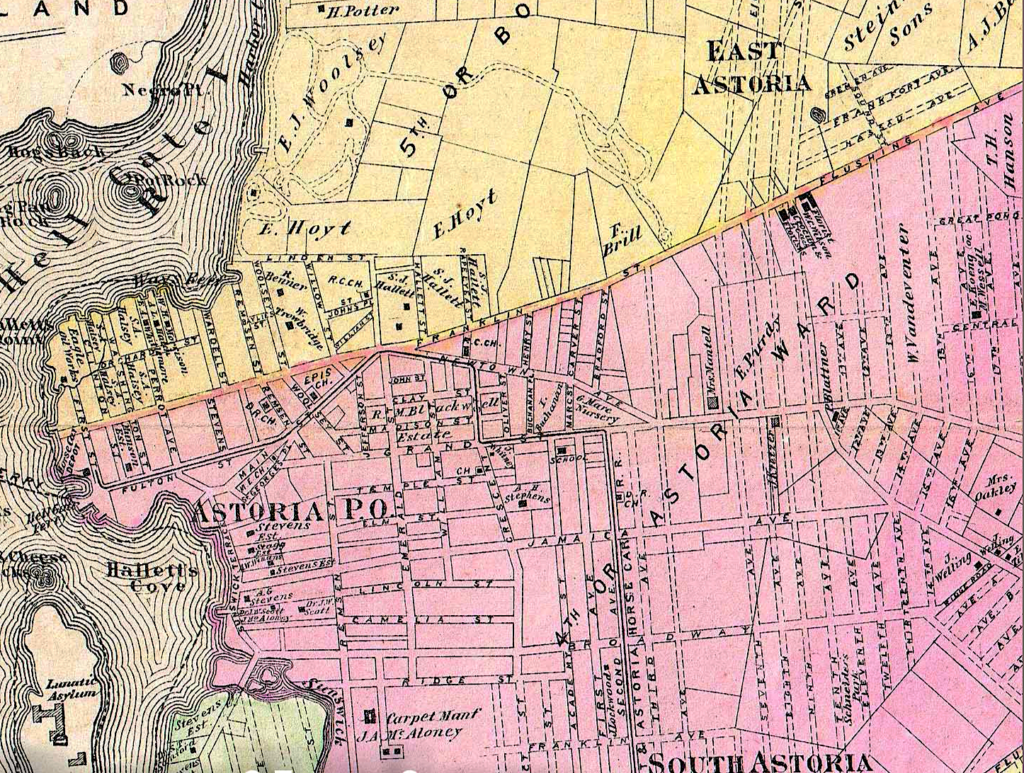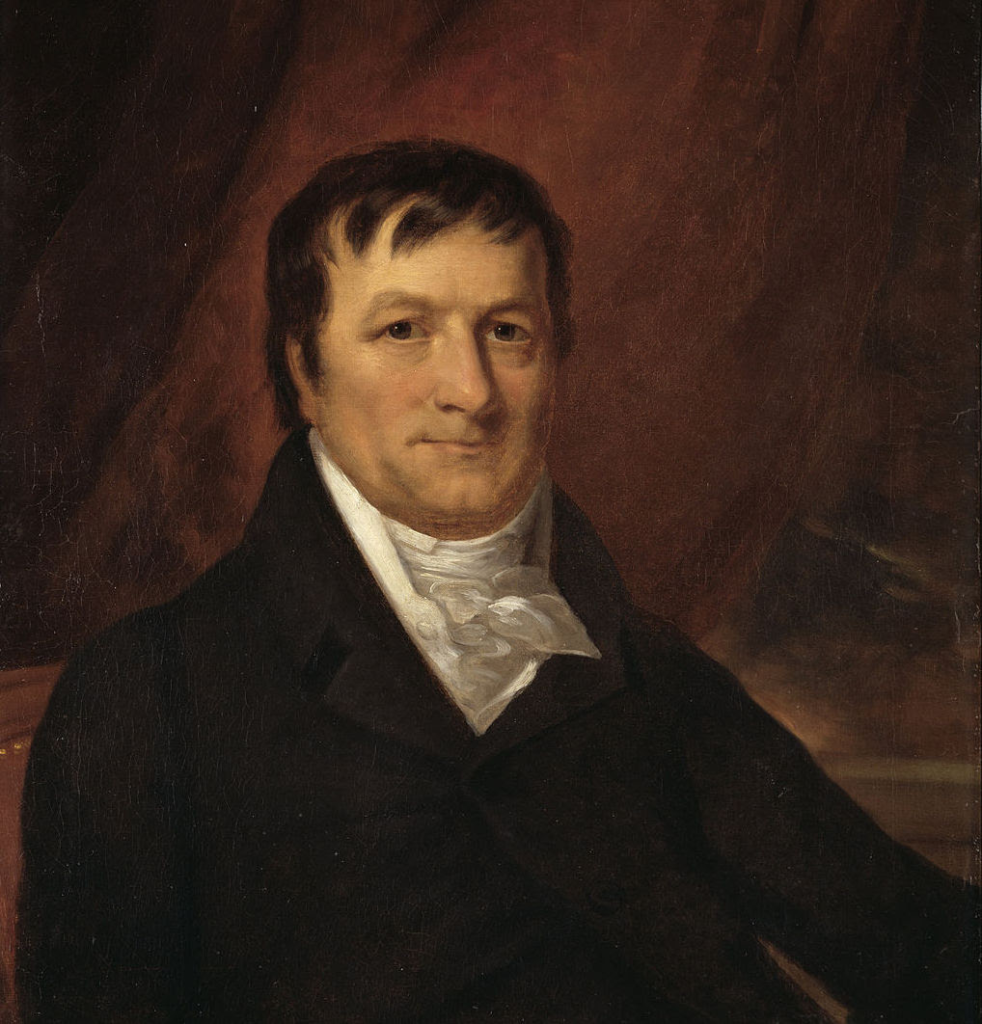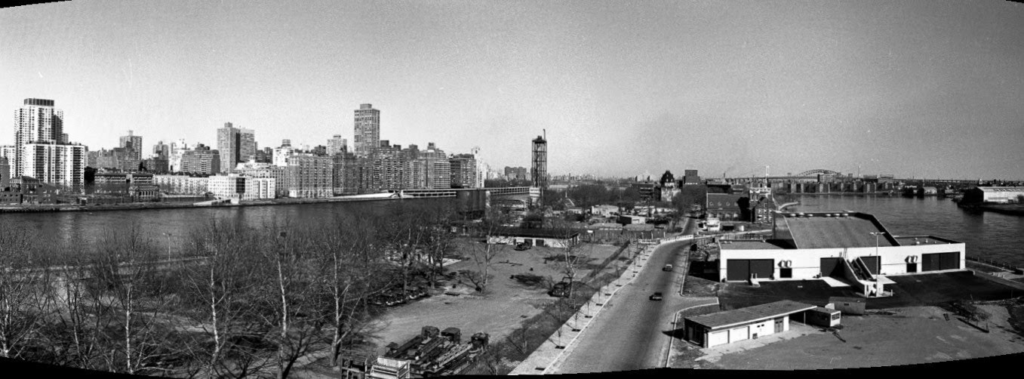Tuesday, May 2, 2023 – MORE GOODIES ABOUT OUR NEIGHBORS IN ASTORIA


FROM THE ARCHIVES
MONDAY, MAY 2, 2023
ISSUE 979
THE SCHEME
BEHIND HOW ASTORIA
GOT ITS NAME
Ephemeral New York
Some long-established New York City neighborhoods got their names from nearby natural landmarks; others took the moniker of an early landowner or the landowner’s hometown in England or Holland.

But the story behind the name Astoria, in Queens, is a little more about wheeling and dealing. It focuses on an ambitious 19th century developer who was hoping that New York’s richest man, John Jacob Astor, would invest thousands of dollars to help build the neighborhood if it carried Astor’s name.
First, a brief history of the East River enclave that would become Astoria. Colonized by the Dutch in the early 17th century, the area was occupied by William Hallett’s vast farm. Hallett lent his name to what was then called Hallett’s (also spelled Hallet’s or Halletts) Cove, which is marked on the 1873 map below.

“Over the next 100 years, Hallett and his descendants developed the area into a thriving farming community,” wrote Ilana Teitel in a piece on the website of the Old Astoria Neighborhood Association. “Early settlers transported grains, livestock, timber, and firewood across the river from Hallets Cove to the growing city of New Amsterdam.”
By the early 19th century, the Hallett family sold off much of their farmland. Wealthy Manhattanites replaced the farm fields with summer villas, turning Hallet’s Cove into a placid resort area for boating and breezy river strolls.

The slow pace of the area began to change with the arrival of Stephen Halsey in 1835. A fur trader, Halsey had big plans for Hallett’s Cove. His idea was to develop it into a modern town with houses, businesses, churches, and factories. But he needed money to get things going.
That’s where Astor (above) came in. “Halsey had connections to the biggest fur trader of the time, John Jacob Astor,” explained Teitel. “He proposed that Astor donate $2,000 towards the construction of a new Episcopal female seminary in exchange for naming the village after him.”

An 1896 article in the New York Times recalls a slightly different story, with Halsey proposing to Astor that he contribute $10,000 to $15,000. In return, Hallett’s Cove would bear his name.
What was Astor’s response to this idea, which he may have pondered across the East River in his Manhattan country estate house (appropriately named Hellgate, above) off today’s East 87th Street? Teitel wrote that Astor ponied up just $500.
Most sources point out that Astor never visited the enclave that would take his name. But the Times has it that Halsey brought Astor to Hallett’s Cove and showed him around.

“Shrewd old Astor looked about and found that the first church in Astoria was just struggling into existence—St. George’s Episcopal—so he contributed just $50 toward its erection,” stated the Times. “He got the honor of having the village named after him, the church got the $50, and the only unhappy people recorded were Mr. Halsey and his fellow village trustees.”
Even with so little of Astor’s cash, however, Astoria thrived—becoming a diverse residential suburb and manufacturing hub in the consolidated New York City on the 20th century (above, in 1915).
Halsey is also remembered; his name graces a junior high school across the borough in Rego Park. And Hallett’s Cove survives as Hallett’s Point, a luxury high rise.
Years ago I was visiting the Dutch Reformed Church near St. Georges Church (where many Blackwell’s are buried). In the back of the reformed church was an obelisk that was laid on the ground with the name Halsey on it. Here is a story about that monument.
Most historians believe the grave of Astoria’s founding father Stephen Halsey is somewhere in Astoria; but finding where is the difficulty.
The general consensus is that he and possibly his family members’ graves are buried in the overgrown backyard of the First Reform Church of Astoria on the historical manor-house-lined 12th Street. That entire area was built up thanks to Halsey’s efforts, and he donated money to the Reform Church’s congregation to build their first chapel at the site in the 1830s.
“I find this very intriguing,” said the church’s pastor, Reverend Dwayne Jackson. “If the founding father is in our backyard then we’re, in a way, the center of the community.”
Over the last few decades, the backyard of the church has become overgrown, due to declining membership and an aging, busy congregation. If the Halsey’s are there, it’s unclear where.
But a couple of months ago, while some congregation members were clearing away some of the vines and dead branches to make a little garden, they discovered a long, triangular monument that had apparently fallen over sideways at some point and buried deep in the ground.
It turned out to be a cemetery marker. No engraving is visible on the part of the obelisk that is above ground, but many historians believe it might be another key to Halsey.
In his book “300 Years of Long Island City, 1630-1930,” Queens historian Vincent Seyfried shows a photograph of a square object that still remains in the churchyard and identifies it as the stone covering of the Halsey family vault.
But in the photograph, the writing on the stone is arguably legible and today the only word clearly visible is “vault.”
Rumors have it that the Halsey’s remains were moved from the churchyard at some point. Other researchers, including Jim Driscoll of the Queens Historical Society, say they’ve seen some references inferring that Stephen Halsey was first buried elsewhere and then moved to the church.
Halsey was born in 1798 and made a fortune as a fur trader. In the 1830s he had a vision for what is now the Western Queens waterfront and convinced investors and developers to move to the area to set up a town.
Halsey had the idea of naming the place after John Jacob Astor, the famed millionaire, believing that doing so would convince Astor to invest in the new village.
Astor, though, was only mildly interested, and donated only $500 to the Young Women’s Seminary of Newtown.
Records show that there may have been some controversy over the naming of the new town, but in the end, Halsey won and Astoria Village was incorporated by the state Legislature in 1839.
It was also in 1839 when the First Reform Church of Astoria was given money by Halsey for its new chapel on 12th Street. That building stood until 1888, when a fire destroyed it. The present chapel was built in 1888.
Halsey is credited by many historians for initiating the ferry service from Astoria to Manhattan that ran until Robert Moses stopped it in the 1930s.
Halsey died in 1875, an honored man.
Lula Thomas has been a member of the church’s congregation for 40 years. She said a former pastor told her in the 1970s that there was someone very famous buried behind the church somewhere.
When the obelisk was found two months ago, church members were excited, though they don’t know how to proceed.
Seyfried was very surprised to hear about the obelisk, saying that it was either not there or buried and so not visible when he visited the churchyard in the 1970s.
Historians like Bob Singleton and Debbie Van Cura of the Greater Astoria Historical Society believe that the monument could possibly be excavated as part of a movement already underway to historically revitalize the neighborhood.
The Greater Astoria Historical Society has been one of several citywide historical groups that are supporting a drive to landmark the historic 12th Street area, which is lined with impressive 19th century wooden homes and known as Old Astoria Village.
Owners of the old houses, distressed by recent sales to developers and demolitions in their once-quiet neighborhoods, have become active in the landmarking efforts.
“The real story is that Halsey moved to Astoria because he thought it was the greatest place to be,” Van Cura said. “We still think it is.”
TUESDAY PHOTO OF THE DAY
SEND YOUR RESPONSE TO:
ROOSEVELTISLANDHISTORY@GMAIL.COM

MONDAY PHOTO OF THE DAY
North of Main Street showing AVAC being built with one building from the FDNY Training Center still standing. On the west side is the future site of Manhattan Park. In the distance is the elevator tower to the water tunnel construction site.


Text by Judith Berdy
Thanks to Bobbie Slonevsky for her dedication to Blackwell’s Almanac and the RIHS
Thanks to Deborah Dorff for maintaining our website
Edited by Melanie Colter and Deborah Dorff
All image are copyrighted (c) Roosevelt Island Historical Society unless otherwise indicated
ACKNOWLEDGEMENTS
EPHEMERAL NEW YORK
6 Responses to “The scheme behind the way Astoria got its name”
Mykola Mick Dementiuk Says:
May 1, 2023 at 5:36 am | ReplyIn the 1960-70s many Ukrainian people were fleeing from the Lower East Side due to the economic decline of the area and relocating to Astoria, Queens, which offered them better housing and living conditions. I suppose that’s true, but I stayed on the Lower East Side from the 1950s to the late 1990s; no regrets there.ephemeralnewyork Says:
May 1, 2023 at 1:50 pm | ReplyIt’s a true diverse neighborhood, but of course known for its Greek community. People I know who live there consider it the perfect New York City nabe, though it’s getting pricey, I hear…
Louis DeMonte Says:
May 1, 2023 at 9:09 am | ReplyThe female seminary eventually became the rectory of St. George’s church. Eventually the parish chose to demolish it in favor or erecting senior housing on the site. The ensuing construction displaced several graves and the building wrapped around the church to cover the stained glass windows behind the altar. We can thank the foot dragging of Queens preservation and the short sightedness of Gloria d’Amico for the destruction of the building that Astoria was named for.
Very sad…ephemeralnewyork Says:
May 1, 2023 at 1:55 pm | ReplyWhat a loss for the community.
Bob Singleton Says:
May 1, 2023 at 10:32 am | ReplyGreater Astoria Historical Society:This was a nice article that also includes the various details that pop up with each retelling of the story.Halsey, who used to live in Flushing, took the boat home each day he admired the peninsula and thought it would make a great investment. His older brother, John Cook Halsey, also worked for Astor and had founded a trading post in Oregon which he named ‘Astoria.’ (told by a family member but is not mentioned in the wiki entry for Astoria OR)When Stephen told Astor his idea of naming the community, Astor was alledged to have said that he had no intention on “crossing the river to see the place” (perhaps because he could already see it from his front porch at Hell Gate!) but he contributed money for a ‘Female Academy’. Currier and Ives did a print of it – it later became the rectory for St George’s Church. (link below)https://www.prints-online.com/astoria-institute-education-young-ladies-7254659.htmlAttempts to save the buidling or at least get inside to document it were brushed aside and it was torn down a few years ago.ephemeralnewyork Says:
May 1, 2023 at 1:54 pm | ReplyWhat a shame about the rectory. But thanks so much for filling out the story and sharing your Astoria knowledge.
THIS PUBLICATION FUNDED BY DISCRETIONARY FUNDS FROM CITY COUNCIL MEMBER JULIE MENIN & ROOSEVELT ISLAND OPERATING CORPORATION PUBLIC PURPOSE FUNDS.


Copyright © 2022 Roosevelt Island Historical Society, All rights reserved.Our mailing address is:
rooseveltislandhistory@gmail.com

Leave a comment